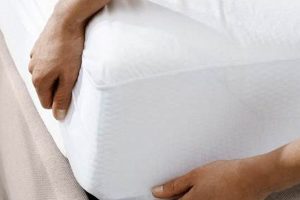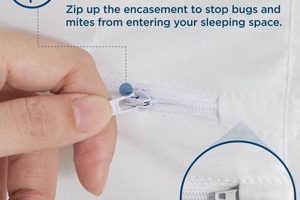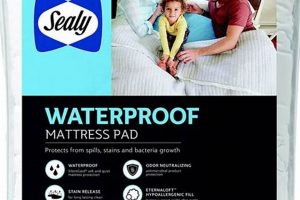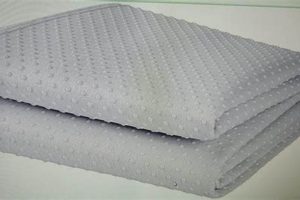A specialized bedding item, designed to encase and safeguard mattresses with a significant depth. These protectors accommodate thicker mattresses, often exceeding the standard dimensions of conventional bedding. For instance, a mattress measuring 15 inches in depth would necessitate this type of protector to ensure a secure and proper fit.
The utility of these protectors lies in their ability to shield substantial mattresses from spills, stains, allergens, and dust mites, thereby prolonging the lifespan of the investment. Their historical context is rooted in the evolving mattress industry, with increasing options for thicker and more luxurious mattresses requiring tailored protective solutions. They contribute to maintaining a hygienic sleep environment and can be particularly beneficial for individuals with allergies or sensitivities.
The following sections will delve into the materials, construction, and care considerations relevant to selecting the appropriate protector for a deep mattress. Key aspects include material breathability, waterproofing features, and the implications for sleep comfort.
Selecting and Maintaining a Deep Mattress Protector
The following provides practical guidance on the appropriate selection and maintenance of protectors designed for extra deep mattresses. Adherence to these guidelines can optimize the lifespan and effectiveness of the chosen protector.
Tip 1: Measure Mattress Depth Accurately: Prior to purchase, ascertain the precise depth of the mattress. An undersized protector will fail to provide adequate coverage, while an oversized protector may result in bunching and discomfort. Use a measuring tape to determine the distance from the top surface to the bottom edge of the mattress.
Tip 2: Prioritize Breathable Materials: Opt for protectors constructed from breathable materials such as cotton, bamboo, or Tencel. These materials promote airflow, reducing the risk of overheating and contributing to a more comfortable sleep experience. Avoid non-breathable materials such as vinyl, which can trap heat and moisture.
Tip 3: Evaluate Waterproofing Effectiveness: Assess the level of waterproofing required based on individual needs. Protectors with a polyurethane membrane offer effective liquid resistance. Ensure the membrane is laminated to a breathable fabric to mitigate heat retention.
Tip 4: Consider Allergen Resistance: For individuals with allergies, select protectors specifically designed to block allergens and dust mites. These protectors typically feature a tightly woven fabric that prevents allergens from penetrating the mattress.
Tip 5: Review Washing Instructions Carefully: Prior to washing, consult the manufacturer’s instructions. Incorrect washing practices can damage the protector’s waterproofing or allergen-blocking properties. Use mild detergents and avoid high heat settings when drying.
Tip 6: Inspect for Damage Regularly: Periodically inspect the protector for signs of wear and tear, such as rips or tears. Address any damage promptly to maintain its protective integrity. Consider replacing the protector every one to two years, or as needed.
Tip 7: Ensure a Snug Fit: Confirm that the protector fits snugly around the mattress, without excessive slack or bunching. A secure fit maximizes protection and minimizes discomfort during sleep.
Proper selection and diligent maintenance of a deep mattress protector will safeguard the mattress from damage, extend its lifespan, and contribute to a healthier sleep environment.
The subsequent sections will address specific product recommendations and address common questions regarding the use and care of these specialized bedding items.
1. Depth Accommodation
Depth accommodation is a primary attribute defining the functionality of an extra deep mattress protector. The term refers to the protector’s designed capacity to fully enclose mattresses with greater vertical dimensions than standard models. This capability directly influences the protector’s effectiveness in preventing damage and maintaining hygiene. Inadequate depth accommodation results in exposure of the mattress sides and corners, rendering the protector’s other protective features irrelevant for those uncovered areas. For example, a protector intended for a 15-inch mattress that is used on a 17-inch mattress will leave the lower edges vulnerable to spills, stains, and allergens, negating much of its intended benefit.
The practical significance of understanding depth accommodation lies in its impact on consumer choice and product performance. Manufacturers specify the depth range a protector is designed to accommodate, often expressed in inches or centimeters. Proper selection involves precisely measuring the mattress depth and choosing a protector within that range. Mismatched depths can lead to either insufficient coverage, as previously mentioned, or excessive material bunching, potentially compromising sleep comfort. This highlights the practical need for retailers and consumers to prioritize accurate measurements and product specifications.
In summary, depth accommodation is not merely a sizing consideration but a fundamental design element integral to the effectiveness of an extra deep mattress protector. Its significance extends from the manufacturing process to consumer selection and ultimately impacts the protector’s ability to perform its core functions. Ignoring this aspect compromises the investment in both the mattress and the protector itself, rendering the protective benefits substantially reduced.
2. Material Breathability
Material breathability plays a critical role in the overall effectiveness and user experience of an extra deep mattress protector. The selection of breathable materials directly impacts temperature regulation, moisture management, and the prevention of microbial growth within the sleeping environment. Failure to prioritize breathability can negate other protective qualities and undermine the intended benefits of the product.
- Air Permeability and Temperature Regulation
Air permeability refers to the ability of a material to allow air to pass through it. In extra deep mattress protectors, breathable materials like cotton, bamboo, or Tencel facilitate air circulation, reducing heat buildup and preventing overheating. This is especially important in thicker mattresses, which tend to retain more heat. Reduced air permeability, on the other hand, can lead to increased body temperature, potentially disrupting sleep patterns and causing discomfort.
- Moisture Wicking and Humidity Control
Breathable materials often possess moisture-wicking properties, drawing perspiration away from the body and allowing it to evaporate. This function is particularly relevant for extra deep mattress protectors, as the increased surface area of a thicker mattress can contribute to greater moisture accumulation. Failure to manage moisture can create a humid environment conducive to bacterial and fungal growth within the mattress, ultimately compromising hygiene and potentially triggering allergic reactions.
- Material Composition and Breathability Trade-offs
Various materials offer different levels of breathability. Natural fibers like cotton and linen are generally more breathable than synthetic materials like polyester or vinyl. However, waterproofing capabilities often require the incorporation of non-breathable membranes, creating a trade-off between liquid protection and air circulation. Advanced protectors utilize breathable membranes, such as polyurethane laminates, to minimize this trade-off, offering both waterproofing and reasonable breathability.
- Impact on Sleep Quality and Comfort
The breathability of an extra deep mattress protector directly influences sleep quality and comfort. A protector that traps heat and moisture can lead to restless sleep, increased tossing and turning, and overall discomfort. Conversely, a breathable protector promotes a cooler, drier sleep environment, fostering more restful and restorative sleep. Consequently, material breathability should be a central consideration when selecting an extra deep mattress protector to maximize its positive impact on sleep.
In summary, the integration of breathable materials within an extra deep mattress protector is not merely a comfort enhancement but a functional imperative. By facilitating temperature regulation, managing moisture, and minimizing the risk of microbial growth, breathable materials contribute significantly to the overall effectiveness and value proposition of these specialized bedding accessories. The informed selection of breathable protectors is crucial for safeguarding mattress integrity and promoting optimal sleep hygiene.
3. Waterproof Barrier
A waterproof barrier constitutes a crucial element in the design and functionality of an extra deep mattress protector. Its presence directly mitigates the risks associated with liquid penetration, thereby safeguarding the mattress core from damage and maintaining a hygienic sleep surface. The effectiveness of this barrier dictates the protector’s overall ability to perform its primary function.
- Protection Against Spills and Stains
The primary role of the waterproof barrier is to prevent liquids, such as water, bodily fluids, or spilled beverages, from reaching the mattress. This protection minimizes the risk of permanent staining, odor development, and structural damage to the mattress foam or internal components. The barrier functions as a preventative measure, extending the lifespan and maintaining the aesthetic appeal of the mattress. For instance, a sudden accidental spill during sleep will be contained on the protector’s surface, allowing for easy cleanup and preventing irreversible damage to the underlying mattress layers.
- Prevention of Mold and Mildew Growth
Moisture intrusion into a mattress creates an environment conducive to the growth of mold and mildew. These microorganisms can compromise the structural integrity of the mattress, emit unpleasant odors, and pose potential health risks, particularly for individuals with allergies or respiratory sensitivities. A properly functioning waterproof barrier prevents moisture accumulation, thereby inhibiting the proliferation of mold and mildew within the mattress core. This preventive measure is crucial for maintaining a healthy and sanitary sleep environment.
- Barrier Integrity and Material Composition
The effectiveness of a waterproof barrier is directly linked to its material composition and construction. Common materials include polyurethane films, often laminated to a breathable fabric layer to balance waterproofing with airflow. The integrity of the barrier is paramount; any punctures, tears, or delamination will compromise its ability to repel liquids. Regular inspection and appropriate care are essential to maintaining the barrier’s protective capabilities. Alternatives include tightly woven fabrics treated with water-repellent finishes, although these may offer a lower level of protection compared to impermeable membranes.
- Impact on Mattress Warranty
Many mattress warranties are voided by damage caused by spills or stains. Utilizing an extra deep mattress protector with a reliable waterproof barrier can help preserve the validity of the warranty by preventing liquid-related damage. The presence of a protector serves as a proactive measure to protect the mattress from potential damage, ensuring that warranty coverage remains intact in the event of other manufacturing defects or issues unrelated to liquid damage.
The waterproof barrier is an indispensable element of an extra deep mattress protector, directly influencing its ability to safeguard the mattress from a range of potential hazards. Its effectiveness hinges on material integrity, proper maintenance, and consistent use. Choosing a protector with a robust waterproof barrier is a critical step in preserving the lifespan, hygiene, and warranty of a substantial mattress investment.
4. Allergen Protection
The integration of allergen protection into extra deep mattress protectors represents a critical feature, directly addressing the presence of allergens within the sleeping environment. The design and materials employed significantly influence the protector’s effectiveness in mitigating exposure to common allergens, enhancing sleep quality and overall well-being.
- Dust Mite Barrier
Dust mites, microscopic organisms that thrive in bedding, are a primary source of allergens. Extra deep mattress protectors designed for allergen protection employ tightly woven fabrics with pore sizes too small for dust mites to penetrate. This barrier effectively prevents dust mites from colonizing the mattress core, reducing exposure to dust mite allergens and associated allergic reactions, such as rhinitis, asthma, and eczema. Regular cleaning of the protector further minimizes allergen accumulation.
- Pet Dander Containment
For pet owners, pet dander represents a significant source of allergens. These microscopic particles, shed from animals’ skin and fur, can accumulate in bedding and trigger allergic responses. Allergen-protective extra deep mattress protectors function as a barrier, preventing pet dander from embedding within the mattress fibers. This containment minimizes the concentration of pet allergens in the sleeping environment, offering relief for individuals sensitive to pet dander. Regular laundering of the protector is crucial to remove accumulated dander.
- Mold Spore Filtration
Mold spores, ubiquitous in the environment, can trigger allergic reactions when inhaled. A waterproof extra deep mattress protector that inhibits moisture accumulation indirectly contributes to allergen protection by preventing mold growth within the mattress. Additionally, some protectors feature fabrics with inherent antimicrobial properties, further reducing the likelihood of mold spore proliferation. Maintaining a dry and clean sleep surface is essential for minimizing mold-related allergen exposure.
- Pollen Mitigation
Pollen, a seasonal airborne allergen, can infiltrate indoor environments and accumulate on bedding surfaces. While not specifically designed to filter airborne pollen, allergen-protective extra deep mattress protectors provide a barrier that prevents pollen from embedding deeply within the mattress fibers. This minimizes long-term exposure to pollen allergens and facilitates easier removal through regular washing. The use of hypoallergenic bedding materials in conjunction with the protector can further reduce pollen-related allergy symptoms.
The implementation of allergen protection within extra deep mattress protectors addresses a significant concern for individuals with allergies or sensitivities. By minimizing exposure to common allergens such as dust mites, pet dander, mold spores, and pollen, these protectors contribute to a healthier and more comfortable sleep environment. The effectiveness of this protection hinges on the choice of materials, the integrity of the barrier, and consistent maintenance practices.
5. Secure Fit
The attribute of “secure fit” is not merely a matter of aesthetics but a critical functional requirement for an extra deep mattress protector. A properly secured protector maximizes its intended benefits, while a poorly fitted one compromises its protective capabilities and user comfort.
- Elimination of Shifting and Bunching
A secure fit prevents the protector from shifting or bunching during sleep. Movement of the protector can expose portions of the mattress, negating the intended protection against spills, stains, and allergens. A snug fit, achieved through elasticized edges or fitted sheet designs, ensures consistent coverage across the entire mattress surface. For instance, a protector that slips off a corner exposes the underlying mattress to potential damage.
- Maintenance of a Smooth Sleep Surface
Excess fabric or a loose fit can create wrinkles and folds, resulting in an uneven sleep surface. These irregularities can cause discomfort, disrupt sleep patterns, and potentially lead to pressure points. A secure fit ensures a smooth, taut surface, contributing to a more comfortable and restful sleep experience. The elimination of wrinkles minimizes the risk of discomfort and promotes consistent spinal alignment.
- Preservation of Protector Integrity
A loose-fitting protector is more susceptible to damage. Increased movement and friction can lead to accelerated wear and tear, including rips, tears, and seam separation. A secure fit minimizes stress on the protector’s material and construction, extending its lifespan and maintaining its protective properties over time. Regular adjustments to a poorly fitted protector can weaken its structural integrity.
- Optimization of Protective Functionality
The full benefits of features such as waterproofing and allergen protection are only realized when the protector remains securely in place. Gaps or exposed areas compromise these functions, allowing liquids or allergens to penetrate the mattress. A secure fit ensures that these protective features are consistently applied across the entire mattress surface. For example, a shifting protector might leave the area around a sleeping individual’s head unprotected from allergens.
The multifaceted nature of “secure fit” underscores its importance in the context of extra deep mattress protectors. It is a functional attribute that directly influences the protector’s ability to safeguard the mattress, maintain user comfort, and extend the product’s lifespan. Choosing a protector with a design that prioritizes a secure fit is crucial for realizing its intended benefits.
6. Durability
Durability, as a characteristic of an extra deep mattress protector, represents its capacity to withstand repeated use and maintain its protective properties over an extended period. Its relevance stems from the inherent investment associated with deep mattresses and the expectation that protective measures will offer long-term value.
- Material Resistance to Wear and Tear
The protector’s fabric composition directly influences its resistance to abrasion, punctures, and tearing. High-denier fabrics, tightly woven structures, and reinforced seams contribute to enhanced durability. For instance, a protector made from a low-quality, loosely woven material is more prone to damage from routine movement and friction, diminishing its protective capabilities. The selection of durable materials is thus paramount in ensuring longevity.
- Waterproof Membrane Integrity
The waterproof membrane, typically a polyurethane layer, must maintain its integrity over repeated washings and usage. Delamination, cracking, or compromised seams render the barrier ineffective, leading to potential liquid penetration and subsequent mattress damage. Superior protectors employ durable membranes that resist degradation under normal conditions, ensuring consistent waterproof performance throughout the product’s lifespan.
- Resistance to Degradation from Cleaning Agents
Frequent cleaning is necessary to maintain hygiene and allergen control. However, harsh detergents, bleach, or high heat settings during washing and drying can accelerate material degradation, compromising both the fabric and waterproof membrane. Durable protectors are constructed from materials that withstand typical cleaning agents and processes without significant deterioration, prolonging their useful life.
- Seam Strength and Construction
Seams are potential weak points in any textile product. Reinforced seams, double stitching, and high-quality thread contribute to the overall durability of an extra deep mattress protector. Weak seams are susceptible to separation under stress, compromising the protector’s fit and allowing for liquid or allergen intrusion. Robust seam construction is thus a critical factor in ensuring long-term performance and protection.
These facets collectively define the durability of an extra deep mattress protector. Selecting a protector that prioritizes robust materials, a resilient waterproof membrane, resistance to cleaning-induced degradation, and strong seam construction ensures that the investment provides lasting protection and maintains its functionality over time. The long-term cost-effectiveness of a protector is directly proportional to its ability to withstand the rigors of regular use and cleaning cycles.
7. Ease of Cleaning
The attribute of “ease of cleaning” is paramount in evaluating the practicality and long-term utility of an extra deep mattress protector. Its importance stems from the protector’s function as a barrier against contaminants, necessitating frequent cleaning to maintain a hygienic sleep environment. The design and material composition of the protector directly influence the ease with which it can be cleaned and sanitized, impacting both its lifespan and its contribution to overall sleep health. For example, a protector constructed from a material that requires specialized cleaning agents or delicate handling is less practical for regular maintenance than one designed for conventional machine washing and drying.
Considerations regarding “ease of cleaning” include the fabric’s stain resistance, its ability to withstand repeated wash cycles without degradation, and the suitability for conventional laundering methods. Protectors that are machine washable and dryer-safe offer greater convenience and reduce the time and effort required for upkeep. Furthermore, the presence of features such as stain-resistant treatments can minimize the need for harsh cleaning agents or prolonged soaking. For instance, a waterproof protector that readily releases spills with a simple wipe-down requires less intensive cleaning than one where stains permeate the material.
In summary, “ease of cleaning” is an integral factor to consider when selecting an extra deep mattress protector. Its influence extends beyond mere convenience, impacting the protector’s longevity, its effectiveness in maintaining hygiene, and its overall value proposition. Prioritizing protectors designed for simplified cleaning protocols ensures the long-term benefit and practicality of this essential bedding item.
Frequently Asked Questions
The following addresses common inquiries regarding extra deep mattress protectors, providing clarity on their functionality, selection, and maintenance.
Question 1: What constitutes an “extra deep” mattress necessitating a specialized protector?
An “extra deep” mattress typically refers to models exceeding standard depths, often ranging from 14 to 20 inches or more. Conventional mattress protectors may not adequately encase such mattresses, necessitating a protector specifically designed for greater depths.
Question 2: How does one accurately measure mattress depth to ensure a proper protector fit?
Accurate measurement requires a flexible measuring tape. Extend the tape from the top seam of the mattress to the bottom seam, ensuring a straight and perpendicular line. The resulting measurement indicates the required protector depth.
Question 3: Are all waterproof extra deep mattress protectors inherently non-breathable?
Not necessarily. Modern protectors often utilize breathable waterproof membranes, such as polyurethane laminates, which allow for air circulation while preventing liquid penetration. It is essential to review product specifications to ascertain breathability.
Question 4: How frequently should an extra deep mattress protector be laundered?
Laundering frequency depends on individual usage and environmental factors. However, a general guideline is to wash the protector every 1-2 months, or more frequently if spills or soiling occur. Adherence to the manufacturer’s care instructions is crucial.
Question 5: Can an extra deep mattress protector truly prevent dust mite infestations?
Protectors employing tightly woven fabrics with small pore sizes can effectively block dust mites from colonizing the mattress. Consistent use and regular laundering are essential for maintaining this protective barrier.
Question 6: Does the use of an extra deep mattress protector negate the need for a mattress pad?
A mattress protector primarily serves to safeguard against spills, stains, and allergens. A mattress pad, conversely, is primarily intended to enhance comfort and provide additional cushioning. The choice to use both depends on individual preferences and needs.
Understanding these fundamental aspects of extra deep mattress protectors facilitates informed decision-making and ensures optimal protection for the investment in a substantial mattress.
The subsequent section will explore purchasing considerations and product recommendations within the realm of extra deep mattress protectors.
In Summary
This discourse has detailed the critical attributes defining the efficacy of an extra deep mattress protector. Depth accommodation, material breathability, waterproof capabilities, allergen protection, secure fit, durability, and ease of cleaning have been elucidated as essential factors determining the product’s overall value and functional performance. These elements collectively contribute to the safeguarding of substantial mattress investments and the promotion of a hygienic sleep environment.
The informed selection and consistent maintenance of an extra deep mattress protector represent a proactive measure in preserving mattress integrity and optimizing sleep quality. Given the potential costs associated with mattress damage and allergen exposure, this protective measure warrants careful consideration and diligent implementation to maximize its long-term benefits.


![Best Purple Protector Mattress: [Benefit] & Protection! Organic & Natural Mattress Buyer’s Guide: Non-Toxic Sleep Solutions Best Purple Protector Mattress: [Benefit] & Protection! | Organic & Natural Mattress Buyer’s Guide: Non-Toxic Sleep Solutions](https://mattressworldpa.com/wp-content/uploads/2025/07/th-2530-300x200.jpg)




